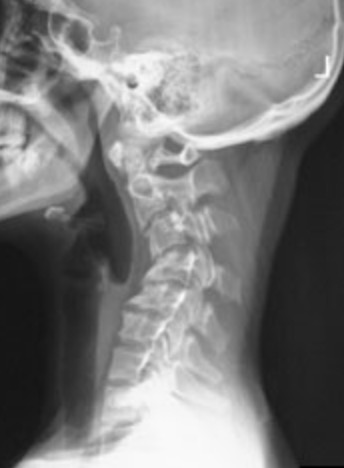Article reviewed and approved by Dr. Ibtissama Boukas, physician specializing in family medicine
Cervical kyphosis is present in children and adults, and can arise from several causes. Early diagnosis and appropriate treatment will be essential to prevent the onset of potentially serious disorders.
What is cervical kyphosis, and what are the symptoms? How to treat it? This article explains everything you need to know about this condition affecting the spine.
Definition
Normally, the term kyphosis refers to a physiological “C” shaped curvature of the spine. It is present at the dorsal spine, and is the opposite of lordosis (which is “inverted C” shaped).
The level of cervical spine, the curvature is assumed to form a lordosis. If it loses its lordotic shape and begins to curve forward, this is an abnormal condition called “cervical kyphosis”. This abnormal forward curvature can lead to spinal problems, in addition to an unusual appearance.
The loss of normal cervical lordosis can be localized, that is to say, only concern one or a few segments of the vertebrae, or the majority of segments of the vertebrae. cervical spine.
Causes
There are several causes of cervical kyphosis. This condition can develop in both children and adults.
Laminectomy
This is the most common cause of cervical kyphosis. This iatrogenic cause (resulting from a medical procedure) occurs more in children compared to adults.
A laminectomy is a type of surgical procedure where a spinal lamina(s) is removed to relieve pressure on the spinal cord and spinal nerves. To find out everything about this operation, see the following article.
In the cervical spine, complete removal of the vertebral laminae can lead to problems with facet joint stability. This can cause the neck to tilt forward and thereby lead to cervical kyphosis.
Another surgery that can lead to this condition is arthrodesis. This is an operation where vertebrae are fused to increase stability and in particular to correct disc problems. On the other hand, if it is not carried out properly (or if it heals poorly), arthrodesis can cause cervical compression which will gradually modify the curvature, and lead to cervical kyphosis.
Degenerative disc disease
La degenerative disc disease is a common cause of cervical kyphosis. As the discs sag and thin, the head tilts forward and the neck begins to curve forward. This process, over time, can lead to a change in the curvature of the cervical region from normal physiological lordosis to pathological cervical kyphosis.
congenital
The second cause of cervical kyphosis is congenital. This refers to a birth defect affecting the development of the spine. A baby can be born with a spinal condition causing a reversal of curvature in the neck.
Unfortunately, this birth defect does not come alone, and is often accompanied by other malformations in other parts of the body. We think in particular of the kidneys and the urinary system.
Trauma
The third cause of cervical kyphosis is traumatic, that is, it results from injury to the cervical spine.
This may be a compression fracture of the vertebra, or damage to the ligaments at the back of the cervical spine after an accident (such as a cervical sprain or whiplash).
After a fracture at the cervical level, for example, the vertebral body may lose its circular shape to a triangular shape. This can cause a change in the normal curvature of the neck, leading to cervical kyphosis.
Other experience
Other less common causes of cervical kyphosis include:
- infections
- you die
- ankylosing spondylitis
- post-radiotherapy
- cervical dislocation
Symptoms of the disease
Cervical kyphosis can cause symptoms of varying degrees of severity. They can range from simple aesthetic changes to chronic pain, passing through more or less severe neurological disorders (such as paralysis).
Symptoms will largely depend on the exact location of the cervical kyphosis, as well as nerve and/or spinal cord irritation. We can see :
- Cervical and neck pain
- Limitation of cervical amplitudes, and neck stiffness
- Numbness and tingling in the upper limbs (nerve damage)
- Muscle weakness sometimes leading to paralysis (spinal cord damage)
- Sphincter disorders and incontinence (rare medical emergency)
Treatment
Treatment for cervical kyphosis will depend on its cause, the patient's symptoms, and whether the structures essential to the functioning of the body (such as the spinal cord) are affected.
In mild cases, the doctor will start with medication, an exercise program to stabilize the cervical region and increase mobility, and a cervical collar if needed.
Surgery
If the deformity is fixed (that is, it does not worsen over time) and the nerves are not affected, then surgery will not be recommended as a matter of course. Indeed, it is quite an invasive procedure and a serious operation. On the other hand, the operation will be indicated (and sometimes even urgently) when the condition is associated with neurological disorders.
Today, surgery to treat cervical kyphosis usually involves spinal fusion combined with a metal rod to maintain proper alignment and straightening of the neck. An osteotomy is sometimes part of the surgical procedure in certain cases (for example, in the presence of ankylosing spondylitis).
As this is a complex operation, the medical team will have to weigh the pros and cons, based on factors such as:
- the progression of the deformation
- the severity of the deformation
- the importance of pain and other symptoms
When indicated, early surgery usually gives better results, and may also prevent the progression of cervical kyphosis. When the operation is not indicated, the patient still benefits from close follow-up to monitor the evolution and prevent serious problems.

